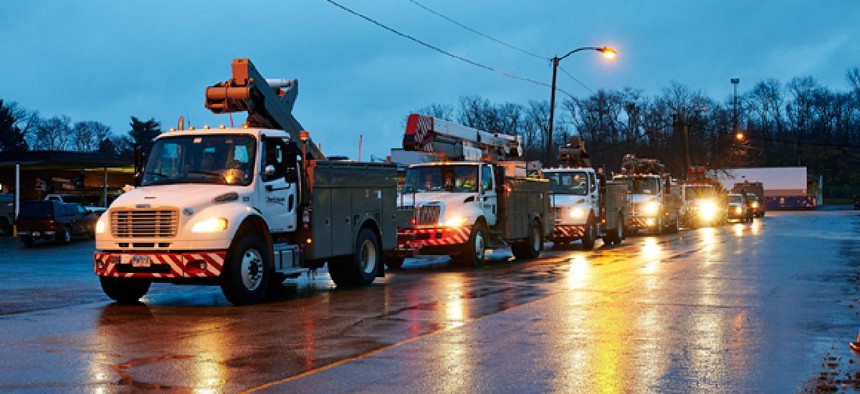Internet, phone companies brace for Hurricane Sandy

Line crews and support personnel leave from Ohio and head to New Jersey in advance of Hurricane Sandy. FirstEnergy Corp./AP
High winds, rain and possible power outages have the potential to play havoc on networks
Communications providers and federal officials were bracing for widespread problems on Monday as Hurricane Sandy bore down on the East Coast.
The high winds, rain, and possible power outages have the potential to play havoc with phone and Internet networks and companies spent the weekend prepping emergency reaction teams.
Washington-area communications networks faced similar strains last year. When an earthquake rattled the East Coast in August 2011, some wireless networks were quickly overwhelmed with traffic.
When Hurricane Irene moved up the East Coast a week later, thousands of customers lost cable, phone, and other services, but companies said the damage was not as extensive as feared.
Telecommunications companies are hoping that their preparations will limit outages during Hurricane Sandy as well.
“Verizon wireline and wireless business units have activated national and regional command and control centers, enabling Verizon operations teams to monitor the storm's progress and company operations, including network performance,” Verizon said in a statement.
AT&T said it has an “arsenal of disaster response equipment and personnel” on standby. Other carriers also reported that they had been investing to make their networks more reliable.
“T-Mobile has made significant investments throughout the year in supplemental cell site backup generators, microwave technology equipment, and cell-on-wheels (COWs), along with other tools and equipment to enhance the stability and, when necessary, the recovery of our network operations,” the company said in a statement.
The Federal Communications Commission urged wireless customers to use text messages, rather than telephone calls during emergencies. Text messages don’t burden telecom networks as much as telephone calls or mobile data usage.
Federal officials could use a mass message alert system that was deployed earlier this year. With the Commercial Mobile Alert System, federal emergency officials could send geographically targeted messages (separate from regular text messages) to telephones that are compatible.
“Alerts are geographically targeted, so a customer living in New York would not receive a threat if they happen to be in Chicago when the alert is sent,” the FCC says. “Similarly, someone visiting New York from Chicago on that same day would receive the alert.”
The system is designed to complement the more-traditional emergency-alert system used by broadcasters.
The National Association of Broadcasters, for example, used promoted tweets on Twitter over the weekend to highlight broadcasters’ role in emergency communications. NAB, which is locked in a fight with wireless companies for valuable spectrum, is quick to tout the emergency benefits of broadcasting stations.
"Broadcasters are a trusted resource for millions of Americans who rely upon local radio and television stations for accurate information during times of emergency," NAB President Gordon Smith said in a statement at the beginning of the 2012 hurricane season. “Indeed, no technology can replicate broadcasting's reliability in reaching mass audiences and providing a lifeline support in emergency and disaster situations."
NEXT STORY: #Sandy hits government


